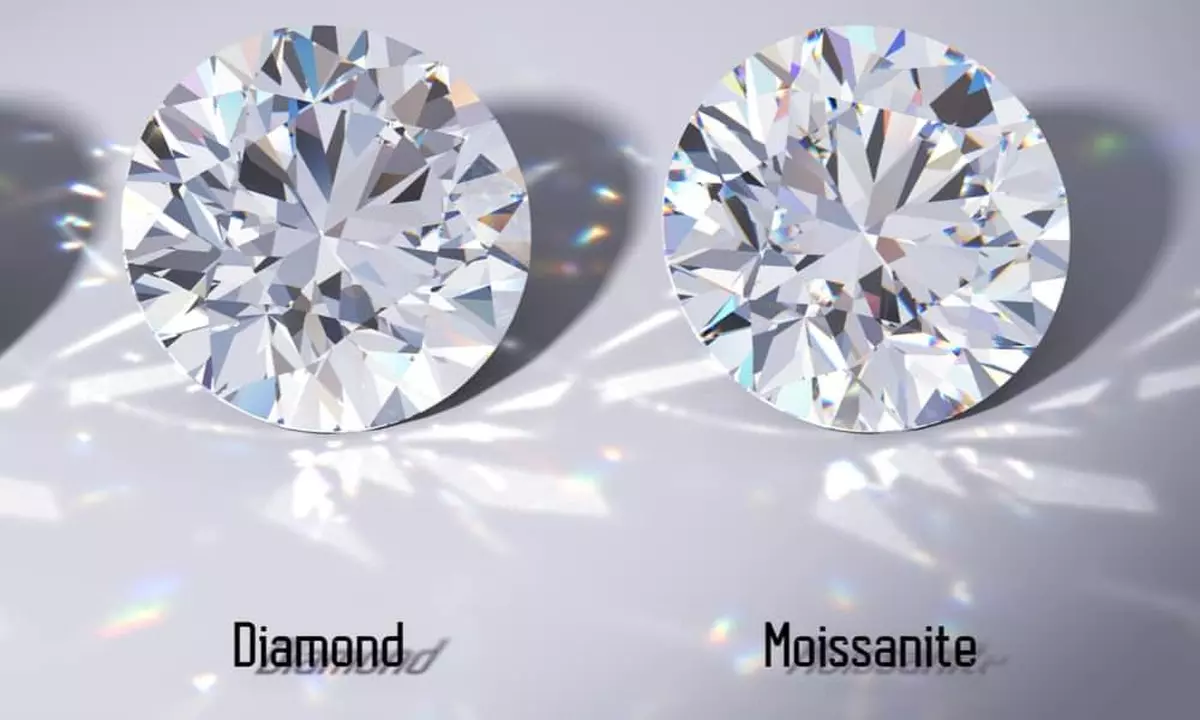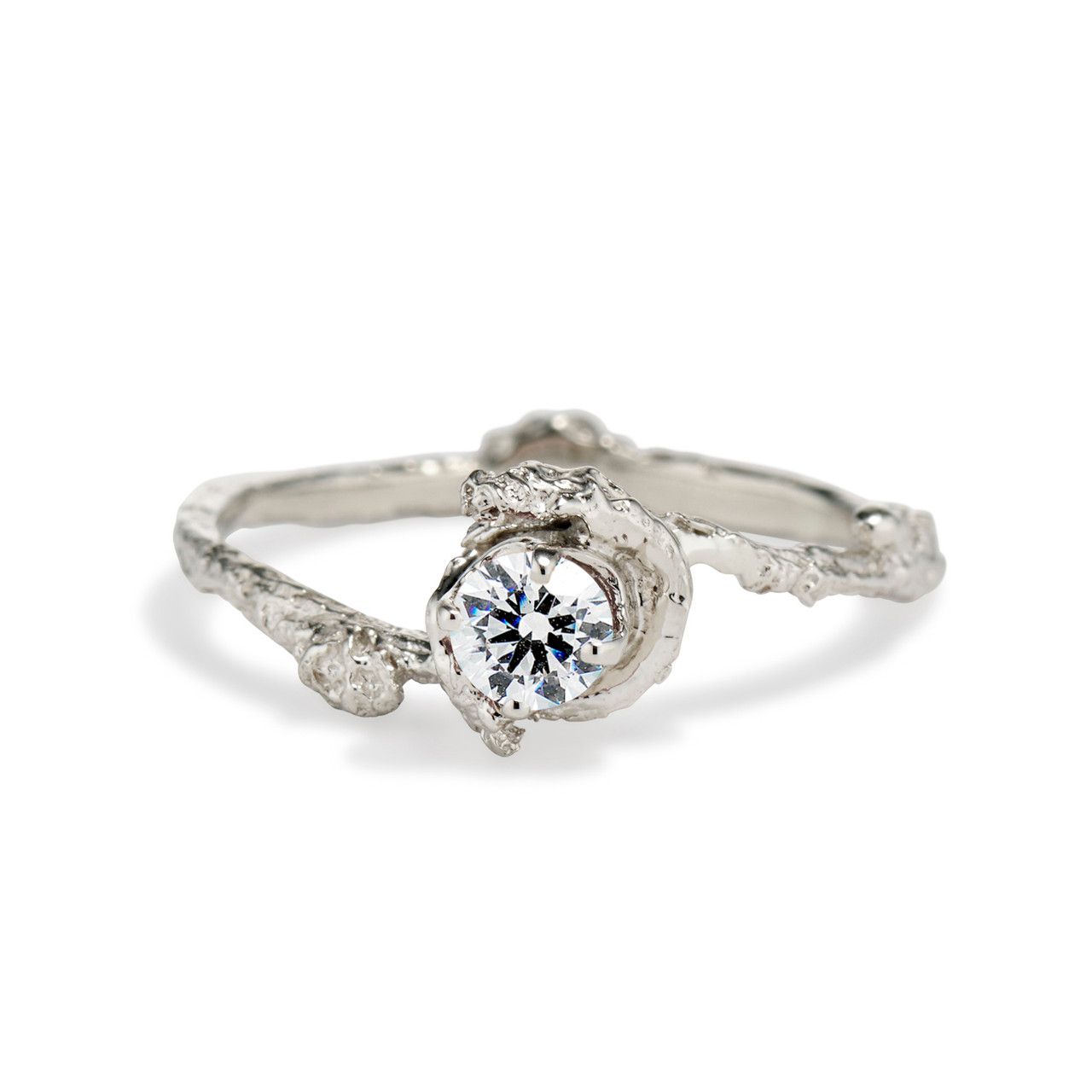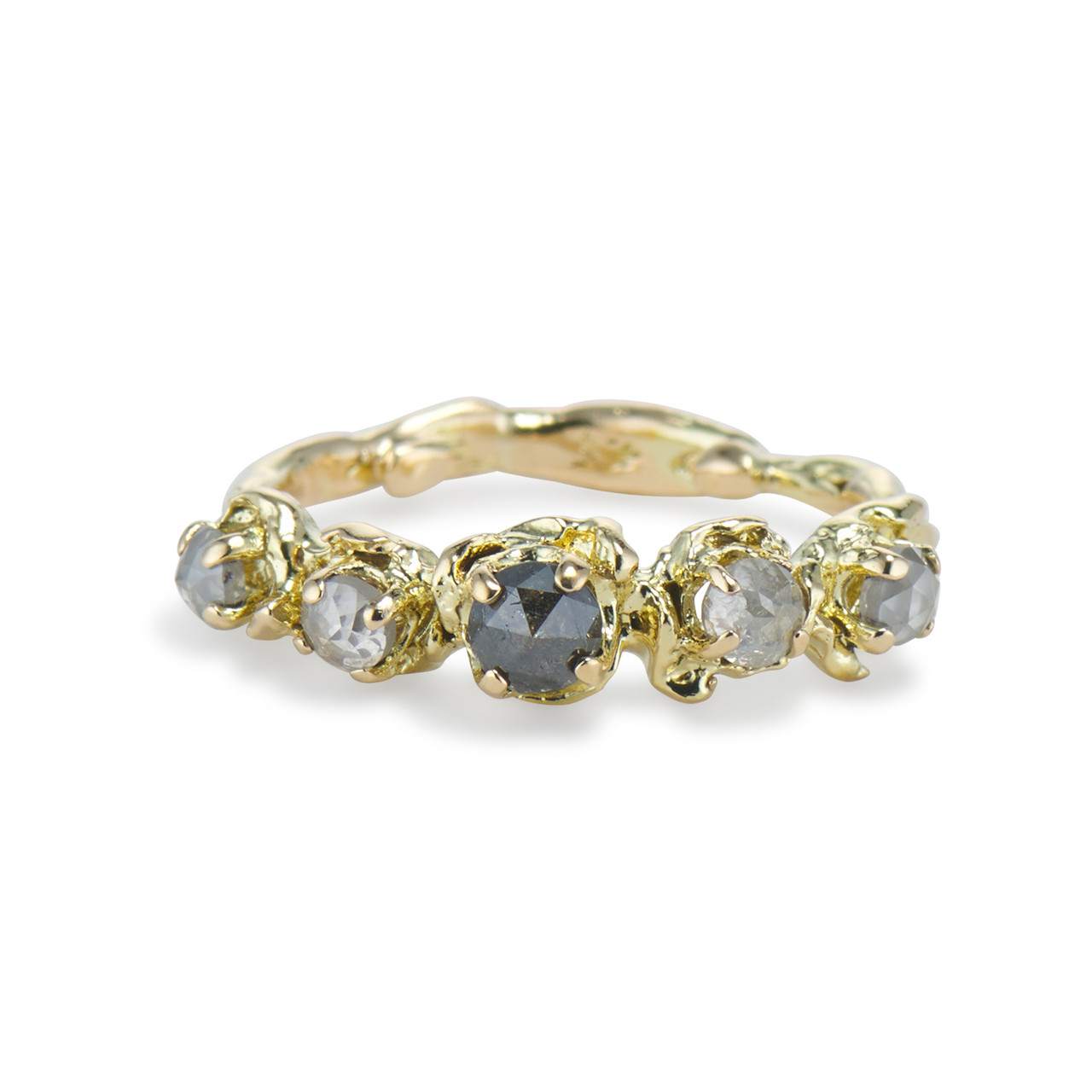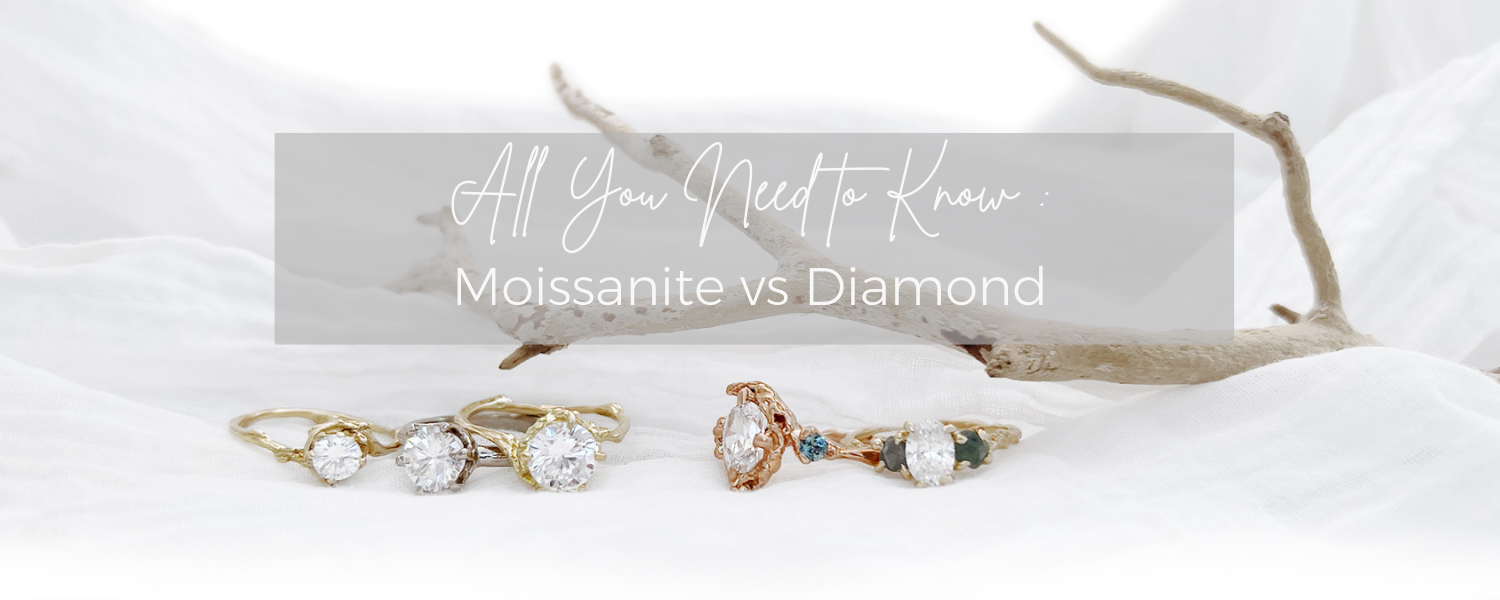Posted by Olivia Ewing on 6th Jul 2022
View Post
COMPARING AND CONTRASTING THESE SPARKLY GEMS
Let's play a game. We're thinking of a gemstone that is beloved by brides. It's prized for its durability, brightness, and lack of color and is incredibly rare. Any guesses?
If you guessed a diamond, you would be wrong.
The gemstone we're thinking of is moissanite! Today, moissanite is becoming an increasingly popular option for people who want the sparkle of a diamond without the price. But what exactly is moissanite and just how similar is it to the diamond?
We’ve compiled this handy guide that answers all of your diamond vs moissanite questions below but first let’s break down exactly what both a moissanite and a diamond are.
WHAT ARE MOISSANITE GEMSTONES?

NAPLES MOISSANITE AND MONTANA SAPPHIRE TRIO
Moissanite is out of this world. Truly.
The sparkling gemstone was discovered in 1893 by Dr. Henry Moissan when he directed his efforts on studying the chemical composition of the fragments of a meteor in Diablo Canyon, Arizona. While he initially believed the moissanite he found to be diamond, he later determined that it was a mineral made up of silicon carbide.
Silicon carbide is an extremely rare mineral on earth. In fact, it is so rare that all of the moissanite sold in the world is lab-created. Yet, despite its earth-rarity, moissanite is incredibly common in space. Natural moissanite, subjected to chemical and mineral analysis reveals that “anomalous isotopic ratios of carbon and silicon, indicating that [the moissanite] originated outside the solar system”.
HOW IS MOISSANITE FORMED?

In a lab, moissanite is created much like a diamond. Instead of a carbon seed, a silicon carbide seed is subjected to a process called Sublimation that utilizes extreme heat and pressure to produce moissanite.
WHAT IS THE HISTORY OF MOISSANITE?
Even though moissanite was discovered in 1893 it was believed to be a diamond until 1904 when it was properly identified as silicon carbide and renamed after Moisson. Thanks to its rarity, naturally occurring moissanite wasn’t found again until the 1950s.
Over thirty years later, in 1987, Cree Research developed the high heat and pressure method mentioned above to create the moissanite. The process was patented in 1998 and was marketed as a superior diamond alternative straight from the stars.
WHAT IS THE TYPICAL APPLICATION OF MOISSANITE?

KNOX MOISSANITE THREE STONE RING
Moissanite is a gemstone that is primarily used as a decorative gemstone in engagement rings, necklaces, earrings and bracelets. Thanks to its hardness ( moissanite is rated 9.5 on the Moh Scale), moissanite can be utilized in everything from body armour to lightbulbs to automobile parts and more.
The second most important application of moissanite is as an industrial abrasive.In addition to its hardness, its highly refractive surface makes it especially suitable for applications in polishing metal surfaces, sanding glass and ceramic materials such as porcelain and enameled metal. The next time you run your hand over a piece of sanded wood you can thank moissanite for the absence of splinters.
WHAT ARE DIAMONDS?

Diamonds are known and loved for being the stone of choice to propose with and we’ve spoken at length about the diamond (which you can read here), so we’ll just focus on the basics.
A diamond is a gemstone that is formed deep within the earth’s crust as a result of immense heat and pressure but are also able to be grown in a lab thanks to high pressure high heat (HPHT) and chemical vapor distillation (CVD) processes.
As is the case with a moissanite, diamonds are appreciated for their sparkle and hardness. Outside of jewelry, diamonds are used to help
scan for cancer, play music, and as an abrasive agent in industrial applications.
MOISSANITE CHARACTERISTICS VS. DIAMOND CHARACTERISTICS

Via Hindu Business Line
So, when compared directly, how does moissanite stack up against diamond? Keep reading to find out!
MOISSANITE HARDNESS VS. DIAMOND HARDNESS
A Diamond is celebrated for their durability and no wonder why. Diamonds rank 10/10 on the Moh Scale of Hardness and can be up to 10x harder than the next hardest mineral, corundum (aka sapphires and rubies), which is a close second in terms of hardness.
However, diamonds aren't the only hard substance on Earth—and moissanite certainly gives them a run for their money. While the hardness of moissanite can fluctuate based on the individual characteristics of each stone, moissanite usually lands somewhere between 9.25-9.5/ 10.
Because the Moh’s scale is a measurement of durability, this means that both moissanite and diamonds make an excellent choice for people who have to use their hands for a living and are often exposed to the elements. These stones are meant to stand the test of time!
CUT MOISSANITE VS. CUT DIAMOND
When we talk about cut moissanite or diamond we are not talking about the stone’s shape, rather we mean the ability of a cut stone to reflect a high brilliance, fire, and scintillation. While GIA has a diamond scale that is used to determine a cut grade, there is no such scale for moissanite. As such, when comparing brilliance, fire, and scintillation in moissanite and diamond, we will be operating on the basis that we are comparing two similar stones in terms of clarity, carat, and color.
BRILLIANCE
Brilliance is the white light that is reflected off of a diamond or moissanite. Brilliance has two components: brightness and contrast, which work together to produce the much sought-after sparkle of a stone.
A bright stone will easily reflect light back out via the stone’s table. If the stone is dull it has often been cut improperly and has deep or shallow cuts that allow for light leakage. A stone’s contrast is how well balanced the brightness of the white light is as it returns to the observer.
When a gemstone has superior contrast and brightness, its brilliance will also be superior. Similarly, a gemstone’s refractive index, or measurement of its ability to refract light, will also reflect a higher brilliance.
While both moissanite and diamond have a high refractive index, moissanite eeks ahead of the diamond with a refractive index of 2.65 to the diamond’s 2.42.
FIRE
The fire of a gemstone, also called dispersion, is the flashes of colored light that you see in the gemstone’s sparkle. Like a rainbow, where a raindrop reflects a beam of light into multiple angles (and thus, colors), so do the facets of a moissanite or diamond stone.
Once more, the moissanite wins thanks to its refractive index and ability to disperse fire at a higher intensity than diamonds (0.104 to 0.044).
SCINTILLATION
Scintillation is the third and final measurement of light as a result of a gemstone cut. It refers to the flashes or sparkles that appear when light is reflected off of a faceted gemstone. When light hits the facets of a diamond, it reflects off in random directions and scatters throughout the room. This creates an effect that makes it look like the diamond is sparkling.
In general, a diamond will give off higher scintillation - bright and clear flashes of light. While moissanite will provide a more colorful and contrasting fire.
MOISSANITE COLOR VS. DIAMOND COLOR

A diamond’s color can be an important factor in deciding to purchase a diamond over moissanite. Generally, a diamond that is pure white is considered to be the most highly desired, however, fancy diamond colors exist. These colors can range from blue and green to pink and everything in between.
Similarly, moissanite is able to be produced in an equal amount of various shades. Moissanite’s color is produced in a lab using the HPHT treatment.
When moissanite was first being developed in labs it was yellow tinged much like the diamond K-grade from GIA. As technology has advanced, most moissanite that is now being produced is closer to colorless as possible.
SOURCING MOISSANITE VS. DIAMONDS

MADRID MOISSANITE SOLITAIRE RING
One of the primary distinctions between moissanite and diamond is how they are sourced. While both of these precious gemstones are able to be found naturally, large quantities of moissanite are so rare that virtually all of the moissanite within the jewelry market is made in a lab.
Diamonds, on the other hand, can be large enough in their natural state to be mined and created in a lab.
MOISSANITE COST VS. DIAMOND COST
For all of the similarities between moissanite and diamond, a shocking difference is its price. Moissanite is usually 1/10th the cost of a diamond.
Why?
This is due to a variety of factors including moissanite's ability to be created in a lab as opposed to being mined which is a large economical and ethical cost, more streamlined production with fewer middlemen, and less of a demand (pursuant to the idea of supply and demand).
DOES MOISSANITE PASS DIAMOND TESTS?

Between appearing and feeling like a diamond, it’s easy to forget that moissanite is not a diamond. In fact, certain diamond testers are unable to distinguish the difference between moissanite and diamonds.
There are two primary forms of diamond testers that are used to determine if a gemstone is a diamond: a thermal diamond tester and an electric diamond tester.
THERMAL DIAMOND TESTER
The thermal diamond tester is a tool that analyzes the "thermal conductivity" of an object. This is a fancy way of saying that it measures how well heat moves through the object. When you put a diamond in the tester and it shows up as "real," that means that it has a high thermal conductivity, which means that it conducts heat well.
However, moissanite has almost exactly the same thermal conductivity as diamonds, so when you put one in there and it says "real," you can't be sure if it is actually a diamond or not.
ELECTRIC TESTER
Unlike a thermal diamond tester, an electric tester is able to correctly identify moissanite. The tester generates a current, which is passed through the stone. If the gemstone in question is moissanite, it will conduct electricity and show a positive reading on the gauge.
HOW TO TELL MOISSANITES AND DIAMONDS APART

Moissanites and diamonds are so similar that moissanite is able to pass certain tests meant only for diamonds.
So if you don’t have an electric tester, how do you tell them apart?
When questioning if your stone is a diamond or moissanite take a look at the stone under bright light. What type of flashes is it reflecting back? If the stone sparkles with a bright white light then it is most likely a diamond. If there is a variety of colors that are emitted in its flash it is moissanite. As we discussed above, because moissanite has a higher refractive index and higher fire than diamonds, the sparkles that it gives off will be multicolored as opposed to white.
Another way to test your stone to determine if it is diamond or moissanite is to weigh it. How light is the stone? Moissanite weighs approximately 15% less than a diamond of the same size. In fact, moissanite is measured in millimeters as opposed to carat weight for this reason.
IS MOISSANITE THE STONE FOR YOU?

NAPLES MOISSANITE HALF HALO RING
If you're looking for a gorgeous, affordable stone that will make your heart sing, moissanite might be the perfect choice for you. Not only are moissanite stones more affordable than diamonds and other precious gems, but they also have an incredible array of colors and sparkles thanks to their high fire, brilliance, and refractive index.
Olivia Ewing Jewelry has a selection of stunning moissanite rings. Each ring is masterfully handcrafted to effortlessly conjure up the wild and romantic natural world and paired with an ethical, certified moissanite stone that is sure to sparkle as vibrantly as your love.
SHOP MOISSANITE ENGAGEMENT RINGS

Meet the Author: Olivia Ewing



